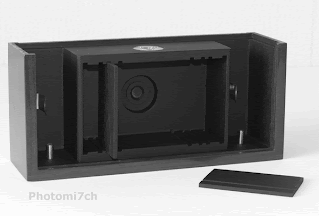
My
darkroom is a very personal space, the only acknowledgement to it
being standard is the separation of wet and dry working areas. It is
just big enough for one person to work in comfortable. A bit of a
glorified closet really! which has meant I have had to find ways of
making the space work hard to meet the needs of both wet-and dry
sides working areas.

One
of the things I have had to do is to put the 12 x16 paper processor
under the work top on a pull out shelf. It was done originally to
save space but has proved to be inspired in a way I had not foreseen.
Being able to look down on the print process has made it a more
relaxed way to work. Keeping the work top clear for other wet side
needs has not worked so well, the top is being dominated by the tray
I use to put the tube covers that keep the chemicals fresh in the
slot processor. It was a large tray so that the tops could be spaced
far enough apart to stop cross contamination.
However,
it all came to a head when I wanted to try a new print developer and
use it with a tray so I could monitor when the first signs of the
image appeared, then transfer it to the processor for stop and fix.
I should explain that the darkroom does not have running water. I
usually part fill a tray with water to put the fixed photographs in
then wash them at the end of the session in the bathroom. Anyway I
had the water tray precariously balanced on top of the slot covers in
their tray as the rest of the top was taken up with the developing
tray. It must have been a good day as I did not manage to tip the
whole lot over myself.
 I
now seriously considered ways of storing the slot tops that would
keep the worktop clear. It came to me that the best way was to stand
them on end. My first thought was to use a number of metal clips
attached to the wall. I cannot understand why I had not come to this
conclusion sooner. Once I had thought about it. It was not such a
good idea as fix attacks metal. I decided it would be better to use
plastic, so took some measurements, sat down and did a number of
drawings of a tray that would hold the tubes upright. Then thought
about how to stop cross contamination, so added sections to the base.
Once I had refined the basic look and measurements I showed the idea
to my mate at Plasweld, he helped to simplify the design and added a
splash back to stop chemicals running all over the place when loading
the tops into the stand.
I
now seriously considered ways of storing the slot tops that would
keep the worktop clear. It came to me that the best way was to stand
them on end. My first thought was to use a number of metal clips
attached to the wall. I cannot understand why I had not come to this
conclusion sooner. Once I had thought about it. It was not such a
good idea as fix attacks metal. I decided it would be better to use
plastic, so took some measurements, sat down and did a number of
drawings of a tray that would hold the tubes upright. Then thought
about how to stop cross contamination, so added sections to the base.
Once I had refined the basic look and measurements I showed the idea
to my mate at Plasweld, he helped to simplify the design and added a
splash back to stop chemicals running all over the place when loading
the tops into the stand.
A
few weeks later the stand is finished. It works very well and has
freed up lots of space on the worktop allowing me to work more
safely. Such a simple idea that has made a big difference.
A typical layout for a darkroom



